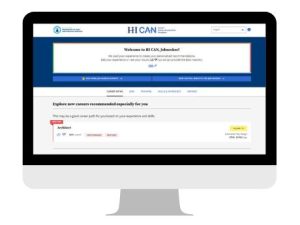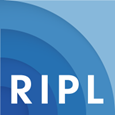A case study of the Hawai‘i Career Acceleration Navigator — an accessible, data-driven and full-service government platform for unemployed people and other jobseekers to search for jobs and access supportive service benefits.
(Download)
In April 2020, the unemployment rate in Hawai‘i reached over 20% as pandemic restrictions disrupted the state’s dominant tourism industry. Like states across the country, Hawai‘i’s unemployment insurance system was overwhelmed by a wave of new benefits applications. Meanwhile, many newly unemployed people were also seeking other services and supports to help them weather unemployment and look for new career opportunities.
This high level of unemployment was taking place against a backdrop of state programs that had long operated in silos, as they do in many states, creating a complex web of requirements for jobseekers to fulfill to access critical services. The unprecedented scale of unemployment, paired with new barriers to accessing services, highlighted the need for more integration within Hawai‘i’s unemployment insurance system. Unemployment insurance claimants often also seek employment services to connect with a new career as well as social services such as cash assistance and health insurance to sustain their families in the short term.
In February 2021, the National Governors Association (NGA) Center for Best Practices awarded Hawai‘i a NGA Workforce Innovation Network (NGA WIN) grant to develop a comprehensive and user-friendly online service delivery hub. Through this grant, the state assembled a forward-thinking, interdepartmental team led by the Hawai‘i Department of Labor and Industrial Relations (DLIR) Workforce Development Division (WDD) to create an accessible, data-driven and full-service government platform for unemployed people and other jobseekers to search for jobs and access supportive service benefits. Beginning in summer 2021, this team partnered with Research Improving People’s Lives (RIPL), a national tech-for-social-impact non-profit, to carry out this work.
Project Overview

RIPL partnered with Hawai‘i’s team of stakeholders in summer 2021 to identify users’ most pressing needs and develop a plan to address them. The team created a vision for a digital hub that would seamlessly connect unemployment insurance claimants and jobseekers to high impact career pathways through personalized, data-driven career transition recommendations and by providing them with information about proven training programs, facilitating direct-to-employer job matching as well as connections to social services. The team named this initiative the Hawai‘i Career Acceleration Navigator (HI CAN).
In the first phase of work, the HI CAN team focused on creating a seamless connection between the unemployment insurance system and the workforce development system. To streamline services between the two systems, the HI CAN team sought to improve the user experience by:
- Creating a user-friendly employment platform that enables users to fulfill their unemployment insurance work search requirement automatically by applying for jobs and tracking their work search activity through a live dashboard connected to the unemployment insurance system.
- Developing a system that provides customized job recommendations for each user based on their unique work and training history as well as information on career transitions that were successful for other users based on an analysis of historical unemployment insurance and wage records.
- Facilitating the creation of a no wrong door entry approach to HI CAN by linking to the site directly from the unemployment insurance weekly work search certification page. Establishing a single sign on (SSO) connection between Hawai‘i Unemployment Insurance (HUI) and HI CAN also enables users to access both platforms through one account, which could be expanded to include other state benefit service accounts.
Key Implementation Strategies
To achieve these goals, the HI CAN team needed bold strategies that embraced a higher standard for government digital services. Success required utilizing innovative technology and data science practices, establishing strong leadership and deliberate collaboration, and conducting extensive testing and user research to drive a highly user-centric experience. The following strategies allowed the HI CAN team to launch a first of its kind platform to connect unemployment claimants with high-impact career pathways and provide other states with information on key lessons learned as they seek to elevate the user experience for unemployed people and other jobseekers:
- Embrace innovative cloud infrastructure to unlock data and create a seamless user experience
- Leverage cutting-edge data science practices, such as machine learning and artificial intelligence
- Foster strong leadership and deliberate collaboration
- Conduct extensive user research and product testing
Embrace innovative cloud infrastructure to unlock data and create a seamless user experience. To power HI CAN, RIPL built a secure, cloud-based Research Data Lake (RDL) environment, which securely houses administrative data from multiple sources including workforce development, unemployment insurance and wage records. Because cloud technology is a recent development, government has been slower than the private sector in adopting it for data storage and digital service delivery. RIPL partnered with DLIR to implement an RDL that uses managed cloud services and components to integrate and anonymize existing government data; create a secure, research-ready environment; and provide data visualization and analysis tools. RIPL’s team of engineers built the infrastructure needed to power the RDL and then worked with Hawai‘i’s technical team to hand over ownership and train them to input additional data and maintain the system. RDLs are low-cost and meet the highest standards of security for government data, and the government retains ownership and full control of the data, along with complete transparency of how information is used through automated auditing and logging. The entire process is automated to maximize reliability and minimize cost. RIPL is working with DLIR to provide staff with the knowledge and resources they need to maintain the RDL and use it to develop rapid and reliable insights to improve service delivery for Hawai‘i communities moving forward.
Leverage cutting-edge data science practices. Hawai‘i’s new cloud infrastructure enables the state to unlock valuable insights and leverage government data to its fullest potential. HI CAN uses a combination of Machine Learning (ML), Artificial Intelligence (AI), state administrative data and cloud computing to generate custom recommendations and job matches. HI CAN delivers recommendations with a level of customization that people have become accustomed to with streaming media or shopping online, because recommendations are informed by previous successful career transitions across the state. This capacity enables greater future research applications within DLIR and across the state, including measuring the impact of policy and programmatic changes.
Foster strong leadership and deliberate collaboration. Even with the cloud infrastructure in place, the level of data sharing and integration Hawai‘i achieved was only possible through a clear vision set out by DLIR leadership and committed buy-in from internal stakeholders and external vendors. High-level support from the Governor’s office and DLIR leadership helped partners understand the value of this initiative to their work, from furthering the mission of their agency to simplifying administrative tasks and improving their applications. For example, the DLIR director helped RIPL engage the unemployment insurance department and communicate how full integration with HI CAN could simplify time consuming tasks like adjudication and reporting. As a result, unemployment insurance department leadership became key members of the HI CAN core team, which was critical when it came time to connect HI CAN to live unemployment insurance records. This connection is what allows the platform to truly function as a one-stop hub for unemployment insurance claimants to access their benefits and search for new career opportunities. Conduct extensive user research and product testing. As HI CAN was developed, the RIPL team conducted extensive user research to solicit feedback from jobseekers in Hawai‘i to ensure the tool is easy to use and provides great value for its intended audience. This research included one-on-one interviews with users on specific features as well as a “soft-launch” of the product, targeting Reemployment Services and Eligibility Assessment (RESEA) participants. Users provided input on the look of the site and their comfortability with the interface as well as feedback on the information and features that would be most helpful to them in their job search. This feedback allowed the RIPL team to make adjustments to the functionality and design to ensure an excellent, user-centric product.
Outcomes and Accomplishments
HI CAN went live in June 2022, making Hawai‘i the first state to implement this groundbreaking approach designed to make it easy for those who have lost their job to find new opportunities more efficiently. HI CAN reduces the number of doors jobseekers must open to connect with benefits and plan for the next step in their career. Providing personalized, data-driven career recommendations (based on each jobseeker’s background) in an easy to use and centralized web application is making it easy for jobseekers in Hawai‘i to connect with opportunities that best meet their needs.
Usership to Date (8/26/2022)
Total Users:
1,094
Clicks to Apply for Jobs:
1,452
Clicks to Explore Career Pathways:
2,288
User Identified Goals:
- Boost Earnings – 34%
- Leverage Skills – 25%
- Enter High Demand Field – 20%
- Not Sure – 21%
RIPL is evaluating HI CAN to assess the impact of the site’s various functionalities. For example, since HI CAN has been integrated with the unemployment insurance system through a single sign-on, seven times more users have navigated to HI CAN. Now, over 80% of HI CAN users log in with their unemployment account credentials rather than creating a new account directly through the site. This finding provides valuable insight on system integration driving the use of digital state government services.
The current HI CAN application is the beginning of Hawai‘i’s long-term plans for this initiative. HI CAN’s cloud technology has expanded capacity for communication and secure data sharing between various state data systems, enabling the state to integrate additional programs and enhance functionalities for users across programs and agencies. For example, while early versions of HI CAN include basic information about social services including the Supplemental Nutrition Assistance Program (SNAP) and Temporary Assistance for Needy Families (TANF) and links to those applications, the state is exploring opportunities to personalize connections made to these programs by using the information available on each user in the RDL.
By combining technology with a human-centered approach, HI CAN will help workers prepare for future jobs by connecting them to promising career pathways and putting the support they need along their journey at their fingertips.
Acknowledgements
This brief was developed in partnership between the National Governors Association Center for Best Practices (NGA Center) and Research Improving People’s Lives (RIPL), as a product of the NGA Workforce Innovation Network. It was prepared by Mintaka Angell, Chief Operating Officer at RIPL; Jade Borgeson, Director of Policy and Partnerships at RIPL; Madelyn Rahn, Deputy Director of Policy at RIPL; Jordan Morang, Workforce Development & Economic Policy Analyst at the NGA Center; and Sophia Yager, Workforce Development & Economic Policy Analyst at the NGA Center.
The authors thank Governor David Ige, the Hawai‘i Department of Labor and Industrial Relations, and all members of Hawai‘i’s state team for their leadership on this work and their commitment to sharing best practices.
Research Improving People’s Lives (RIPL) is a tech-for-social-impact nonprofit that works with governments to help them use data, science and technology to improve policy and lives. RIPL equips policy leaders to create policy that works, delivering measurable improvement per dollar spent for Americans in need. RIPL offers Innovation Catalyst Grants, which fund end-to-end technical assistance to develop customized solutions that are responsive to pressing public challenges. To learn more about working with RIPL to improve lives, please contact the RIPL Chief Operating Officer at innovationcatalyst@ripl.org.

National Governors Association Center (NGA Center) for Best Practices teams develop innovative solutions to today’s most pressing public policy challenges. The center is the only research and development firm that directly serves the nation’s governors. The Workforce Innovation Network is an initiative of the Workforce Development and Economic Policy Program.













